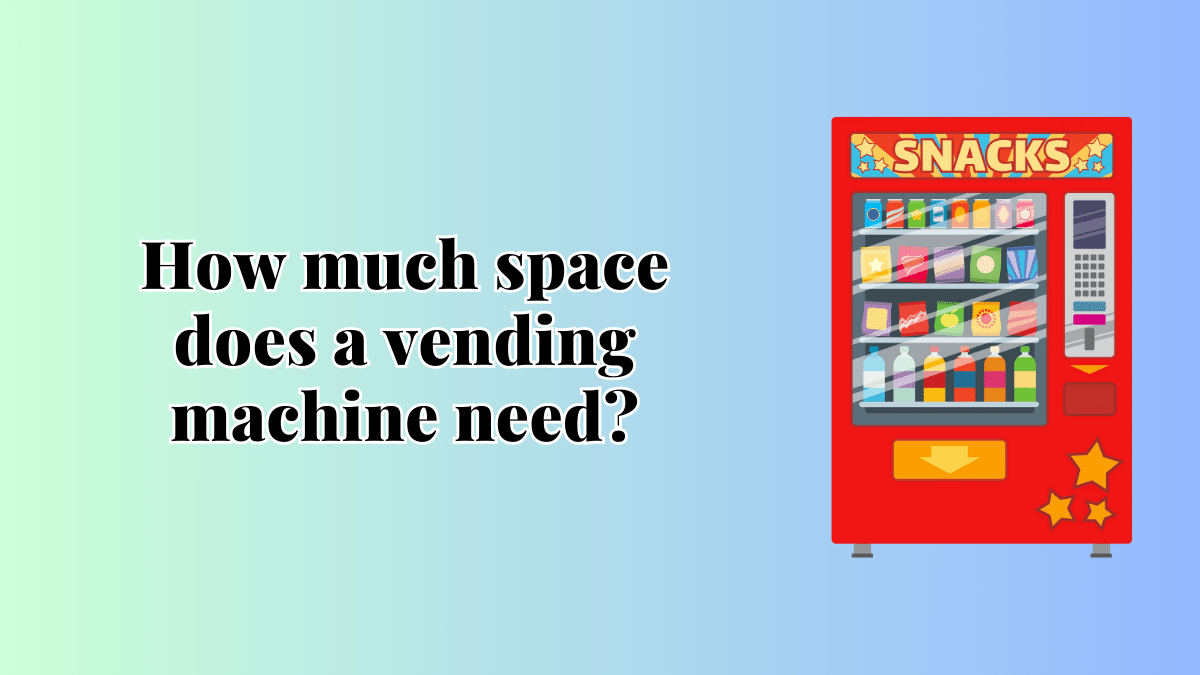Vending machines have become an integral part of our daily lives, providing convenient access to snacks, beverages, and various products. If you’re considering installing a vending machine, a crucial question arises: “How much space does a vending machine need?” In this article, we’ll explore the essential factors affecting the space requirements for vending machines and offer valuable insights to help you make informed decisions. Whether you plan to set up vending machines in schools, offices, or public spaces, understanding the space requirements is vital for ensuring smooth operations and maximizing profits.
Factors Influencing Space Requirements for Vending Machines
Vending machines come in various sizes and configurations, and the space they need depends on several factors. Let’s delve into the key considerations that influence the space requirements:
1. Machine Type and Size
The type and size of the vending machine play a significant role in determining the space it requires. Snack vending machines are usually more compact than combo vending machines that dispense snacks and beverages. Additionally, larger machines with multiple product selections will need more space to accommodate customers and facilitate easy access.
2. Product Selection
The range of products you intend to offer through the vending machine will impact the necessary space. If you plan to provide a diverse selection of snacks, drinks, and other items, you may need a larger machine with more capacity. On the other hand, a machine with a limited product range might require less space.
3. Foot Traffic and Location
The location of the vending machine is crucial in determining its space requirements. High-traffic areas, such as shopping malls or busy office lobbies, may require larger machines to cater to customer demand adequately. In contrast, low-traffic areas may only need smaller vending machines to meet occasional needs.
4. ADA Compliance
The Americans with Disabilities Act (ADA) mandates that vending machines be accessible to individuals with disabilities. ADA-compliant machines often have larger dimensions to accommodate wheelchair users comfortably.
5. Clearance Space
To ensure smooth operation and easy customer access, it’s essential to maintain proper clearance space around the vending machine. Adequate clearance prevents congestion and allows customers to make their selections conveniently.
6. Stocking and Maintenance
Consider the space needed for restocking products and performing routine maintenance tasks on the vending machine. Sufficient space is crucial for vendors to manage inventory efficiently and keep the machine in optimal working condition.
7. Aesthetics and Branding
If the vending machine is part of a marketing strategy or brand promotion, additional space may be necessary for branding materials and visual elements to attract customers effectively.
Optimal Placement of Vending Machines
Strategically placing vending machines can significantly impact their success. Consider the following placement tips:
1. High-Traffic Areas
Install vending machines in locations with high foot traffic, such as shopping centers, airports, train stations, and schools. The increased visibility and accessibility will attract more customers and potentially lead to higher sales.
2. Near Waiting Areas
Placing vending machines near waiting areas, such as bus stops or office lobbies, can capitalize on customers’ idle time, encouraging impulsive purchases.
3. Employee Break Rooms
Office break rooms are ideal spots for vending machines, providing employees with convenient access to snacks and beverages without leaving the workplace.
4. Consider Demographics
Understand the preferences and needs of the target audience in a specific location. Tailor the product selection to cater to the demographics of the area.
5. Accessibility and Safety
Ensure that the vending machine is easily accessible and well-lit for safety purposes, especially if the location operates at night.
How much space does a vending machine need?
A standard snack vending machine typically requires an area of about 16 inches in width, 30 inches in depth, and 76 inches in height. However, these dimensions can vary depending on the machine’s design and product capacity. Combo vending machines usually have slightly larger dimensions to accommodate both snacks and beverages.
FAQs
Q: Can I place a vending machine outside?
A: Yes, you can place a vending machine outdoors, but you need to ensure it is in a covered area to protect it from harsh weather conditions.
Q: How much electricity does a vending machine consume?
A: The energy consumption of a vending machine varies depending on its size, features, and usage. On average, a standard vending machine consumes around 3 to 5 kilowatt-hours per day.
Q: Are vending machines profitable?
A: Vending machines can be profitable, but success depends on factors like location, product selection, and marketing efforts.
Q: Can I customize the products in my vending machine?
A: Yes, you can customize the product selection based on the preferences and needs of your target audience.
Q: How often should I restock the vending machine?
A: The restocking frequency depends on the machine’s location and the demand for products. High-traffic areas may require daily restocking, while low-traffic areas can be restocked less frequently.
Q: Are there eco-friendly vending machine options available?
A: Yes, eco-friendly vending machines that prioritize energy efficiency and use recyclable materials are becoming more prevalent in the market.
Conclusion
Understanding how much space a vending machine needs is vital for successful vending operations. By considering factors like machine type, product selection, foot traffic, and ADA compliance, you can optimize your vending machine placement for maximum profitability. Remember to customize the products to cater to the preferences of your target audience and provide convenient access to snacks and beverages in high-traffic areas. With the right strategies and careful planning, your vending machine venture can thrive and become a lucrative business opportunity.




